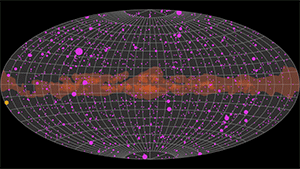
The goal of the Gamma Ray Science Interest Group (GR SIG) is to provide quantitative metrics and assessments to NASA in regard to current and future needs of hard X-ray and gamma-ray astrophysics community. Specifically, the activities of the GR SIG include:
The GR SIG is open to the scientific community. If you are interested in contributing to the work of the GR SIG, please subscribe using the link below.
Subscribe to the
Gamma Ray SIG News and Announcements Email List.